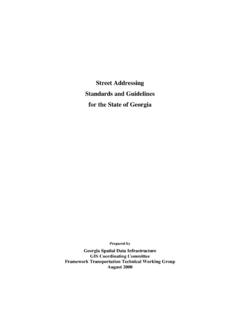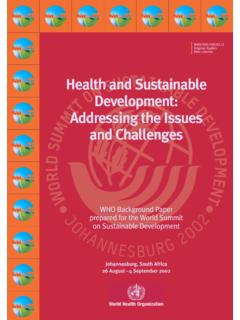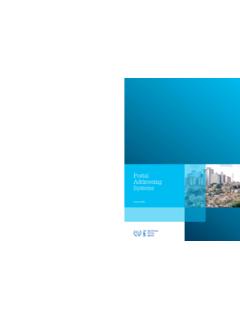Transcription of Notice H 2012-5
1 DEPARTMENT OF HOUSING AND URBAN DEVELOPMENT WASHINGTON, DC 20410-8000 ASSISTANT SECRETARY FOR HOUSING- FEDERAL HOUSING COMMISSIONER As Special Attention of All Multifamily Hub Directors Notice H 2012-5 All Multifamily Program Center Directors Issued: April 23, 2012 All Multifamily Operations Officers All Directors of Project Management Expires: This Notice remains in effect until All Field Counsel amended, revoked, or superseded Cross References: Housing Notice 2011-20 SUBJECT: Guidelines on Addressing Infestations in HUD-insured and Assisted Multifamily Housing I. Purpose This Notice supersedes Housing Notice 2011-20, Guidelines on Bed Bug Control and Prevention in HUD Insured and Assisted Multifamily Housing.
2 Readers seeking guidance on the subject of bed bug infestations should instead refer to this Notice , which provides updated information to prevent and address infestations, including but not limited to bed bugs, insects, and all manner of vermin. HUD is providing guidance to Owners, Management Agents (O/As) and residents of HUD Multifamily insured and assisted properties to remind all parties of the importance of prevention, identification, and treatment of infestations in HUD-assisted and HUD-insured rental housing. The Department has received numerous inquiries and comments from the industry and HUD residents seeking clarification and information on appropriate steps to address infestations in Multifamily properties. This Notice provides information and references to best practices regarding the prevention and control of infestations.
3 It also reaffirms existing program requirements with regard to infestations. II. Background Pursuant to 24 CFR Part 5, Subpart G, HUD housing must be decent, safe, sanitary and in good repair. Owners of HUD-insured or assisted housing must maintain such housing in a manner that meets physical condition standards. In accordance with project Regulatory Agreements and Section 8 HAP Contracts, the housing must have no evidence of infestation. HUD monitors Owners and Agents (O/As) to ensure that housing meets physical condition standards enumerated in 24 CFR This includes providing guidance aimed at preventing and addressing infestations. 2 Many residents and O/As have contacted HUD to seek guidance on infestations. Of particular concern is the growing problem of bed bugs. According to the United States Environmental Protection Agency (EPA), bed bug populations have recently increased dramatically.
4 HUD is working closely with other federal agencies to develop and share best practices for preventing, identifying and controlling bed bugs. III. Applicability This Notice provides guidance to the following types of projects: A. Properties assisted with Section 8 Project Based Rental Assistance, Rent Supplement or Rental Assistance Payment (RAP) contracts. B. Properties with active Section 202 Direct Loans, Section 202/162, Section 202 and 811 Capital Advances, and Section 202 Senior Preservation Rental Assistance Contracts or Section 811 Project Rental Assistance demonstration funding. C. Properties with active FHA insured first mortgages under Sections 207 pursuant to 223(f), 221(d)(3), 221(d)(4), 221(d)(5), 231, 213 or 236. Certain provisions of this Notice are applicable only to assisted properties, as specified in various sections of the Notice below.
5 The Notice does not supersede existing lease provisions that comply with state and/or local landlord/tenant laws and that have been approved by HUD (where such approval is required).1 All parties should refer to the property lease executed between the tenant and the O/A, and the property House Rules, for details on Owner and resident rights and responsibilities related to infestations and housing physical condition standards. Certain assisted properties2 are also subject to provisions of the HUD Model Lease for Subsidized Programs (Family Model Lease) (Form HUD-90105-A, HUD-90105-B, HUD 90105-C and HUD-90105-D) in HUD Handbook , Occupancy Requirements of Subsidized Multifamily Housing Programs. IV. Prevention of Bed Bug Infestations Of particular concern for Multifamily O/As, as well as project residents, is the resurgence of bed bugs, which can cause discomfort and anxiety for residents and which can spread quickly.
6 The ideal approach to bed bug infestations is to prevent them from occurring in the first place. Federal agencies, such as EPA and HUD, are working in tandem to develop and share recommendations to prevent infestations. 1 For unassisted O/As, this Notice does not supersede state and local landlord/tenant law related to lease enforcement, housing habitability, and cure rights or damages. 2 Section 221(d)(3) BMIR, Section 236, Section 8 New Construction, Section 8 Substantial Rehabilitation, Section 8 State Agency, RHS 515 with Section 8, Section 8 Loan Management Set-Aside (LMSA), Section 8 Property Disposition Set-Aside (PDSA), Rental Assistant Payment (RAP), and Rent Supplement projects are subject to the provisions of the Family Model Lease. 3 HUD encourages Multifamily O/As to develop an Integrated Pest Management Plan (IPM) to focus on preventing infestations.
7 Such plans describe the ongoing efforts the property management will take to prevent and respond to pests. For more detail on IPMs generally, please see the online guide at The information below pertains specifically to bed bug infestations. According to the EPA, principles of IPM for bed bugs include: Raising awareness through education on prevention of bed bugs; Inspecting infested areas, plus surrounding living spaces; Checking for infestations on luggage and clothes when returning home from a trip; Reducing the number of secondhand items brought into units and looking for bed bugs or signs of infestation on secondhand items before bringing the items home; Correctly identifying the pest; Keeping records including dates when and locations where pests are found; Cleaning all items within a bed bug infested living area; Reducing clutter where bed bugs can hide; Eliminating bed bug habitats; Physically removing bed bugs through cleaning; Using pesticides carefully according to the label directions.
8 And, Following up on inspections and possible treatments. In addition to or as part of an IPM program, Multifamily O/As are strongly encouraged to take the following steps to prevent bed bugs: Provide training for staff to identify bed bugs, and to perform ongoing prevention actions as outlined in the IPM. When a community is at high risk for bed bugs (for example, if the community has experienced prior infestations), periodic building inspections are recommended. Actively engage residents in efforts to prevent bed bugs. Education and involvement of project residents is a critical component of IPM for bed bugs. Bed bugs may often go undetected and unreported, because they are active at night, and tenants may not be aware of their presence. O/As may wish to hold workshops for tenants to teach them to identify bed bugs, to create unfriendly environments for pests, and to report suspicions of bed bugs as soon as possible.
9 Provide orientation for new tenants and staff, and post signs and handouts. In addition, tenants should immediately report the suspicion of infestations in housing units or other areas of the property. Early reporting allows the pests to be identified and treated before the infestation spreads. Tenants are the first line of defense against infestations and should cooperate to create living environments that deter pests. This includes reducing unreasonable amounts of clutter that create hiding places for pests and deter treatment. 4 More information on bed bug prevention may be found by accessing the following websites:3 Healthy Homes Training: What s Working for Bed Bug Control in Multifamily Housing?: Reconciling best practices with research and the realities of implementation. National Pest Management Association Bed Bug Hub: National Pest Management Association Best Practices Website: IPM Curriculum and Blog: Environmental Protection Agency: bugs/ V.
10 Addressing Infestations The O/A should respond with urgency to tenant reports of infestations. The O/A should endeavor to take appropriate action within a reasonable time period. However, tenants are advised that pest inspections and, if necessary, treatment, may take time to schedule, particularly for recently resurgent pests such as bed bugs, for which it may be difficult to find trained specialists to perform inspections and conduct treatments. Residents should fully cooperate with the O/A s efforts to identify and address infestations. This tenant cooperation is shown to expedite the control of infestations. Cooperation includes allowing the O/A to enter the unit to perform inspections and treatments, allowing pest treatments to occur, following the pest treatment protocol, and removing infested furniture or other items from common areas such as hallways or community rooms.














